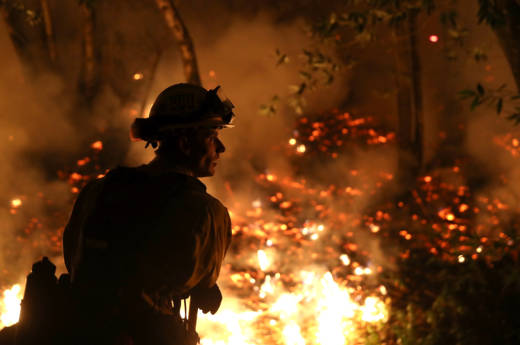Those three fires are:
- The McCourtney Fire, which destroyed 13 structures and burned 76 acres in Nevada County. Cal Fire determined that the fire that started the evening of Oct. 8 was cause by a tree falling into PG&E power lines and found evidence that the utility did not remove a tree from near the power line.
- The Lobo Fire, which destroyed 47 structures and burned 821 acres in Nevada County. Cal Fire determined that the fire that started the evening of Oct. 8 was caused by a tree coming into contact with PG&E power lines and found evidence that there was not enough clearance between trees and the PG&E lines.
- The Honey Fire, which destroyed 76 acres in Butte County. Cal Fire determined that the Oct. 9 fire was caused when an oak tree branch touched PG&E power lines, and found evidence that there was not enough clearance between trees and the PG&E lines.
The largest of the four fires — the La Porte Fire in Butte County — was also caused by tree branches falling into PG&E power lines, but Cal Fire investigators did not find any violations of state law.
Cal Fire spokesman Scott McLean said that these fires all broke out the same night as the devastating blazes in Napa, Sonoma and Mendocino counties and were all fueled by the same dry conditions and extreme windstorms.
PG&E declined an interview request but responded with a written statement that referenced a “new normal” driven by “years of drought, extreme heat and 129 million dead trees.”
“Based on the information we have so far, we believe our overall programs met our state’s high standards,” the statement says. PG&E increased vegetation maintenance and monitoring of it’s over 2 million utility poles in the years of drought since 2014, according to the statement.
The utility giant also referenced its ongoing legal and legislative fight to remove some of its liability for property damage stemming from wildfires started by its transmission lines.
Current law “means PG&E could be liable for property damages and attorneys’ fees even if we followed established inspection and safety rules,” the statement says.
State Senator Jerry Hill of San Mateo, a frequent critic of utilities, pushed back against PG&E’s reference to a “new normal.”
“What the investigation found is clearly the old normal,” he said. “In three cases, there was vegetation that investigators deemed too close to PG&E power lines: trees that should have been maintained but were not.”
“If PG&E is ultimately found to be negligent or didn’t properly maintain vegetation or its infrastructure, then PG&E should pay,” Hill added. “This is why we shouldn’t be rushing special interest reforms through the Legislature that seek to limit utility liability or shift cost burdens from utilities to consumers.”
The Nevada County District Attorney’s Office confirmed it received two investigations from Cal Fire.
Butte County District Attorney Michael Ramsey said his office is reviewing Cal Fire’s report on the Honey Fire and will later determine whether to file charges.
“This is not unlike a series of fires that we had where there was a failure of maintenance around the power lines in the early 2000s,” Ramsey said, adding that it was disheartening to learn that the same failure may have happened again. “We’ve dealt with PG&E in a very similar type situation. So, once again, into the breach.”
The state monitored PG&E’s vegetation maintenance around power lines for several years as a result of the previous case, Ramsey said.
“We put into place some additional safeguards at that time that maybe have been forgotten at this point,” he said. “Of course, we can’t put corporations in jail. What we do is fine them. We’re not as interested in that as much as putting in place those safeguards that we had once before.”
Raquel Dillon of KQED News contributed to this report.

